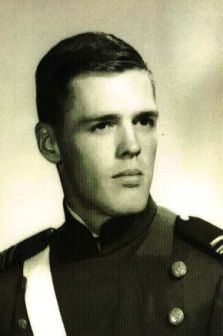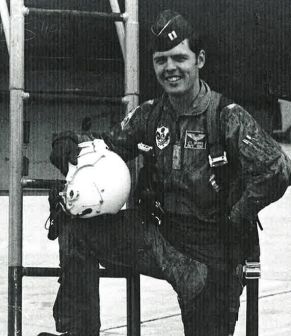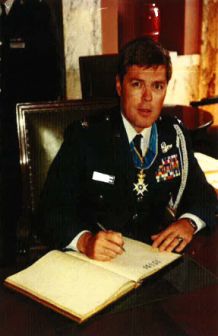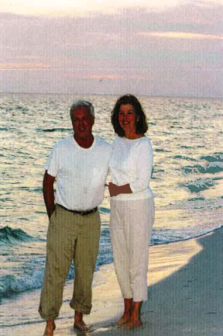
John's History
Decision :
I always wanted to fly fighters since the age of seven. It was 1948 and I lived in Bavaria as a military dependent. My father was an Army officer and his best friend was an Army Air Force officer. The two of them had discovered they lived only thirty miles apart. The pilot asked if my father and I could come to the airfield the next day to see his plane. When we first arrived we saw no one. Five minutes later I saw a speck on the horizon. Then I heard a snarling sound and a roar as a P-51 came over with ten feet between the ground and the propeller tip. He then pulled up and performed aerobatics for twenty minutes over the airfield. He taxied to the ramp amid engine pops and snarls and then shut down the engine. He opened his canopy and yelled, asking that if any boy wanted to sit in a fighter, here it was. I could smell hot oil, hydraulic fluid and the fuel truck pumping gas. There seemed to be over fifty dials in the cockpit. I had to stand on the seat to see over the dash. The pilot put his helmet on my head. I now knew what I wanted to do for life.
Flash Forward to the Air Force Academy 1960:
I was seventeen years old when I entered the Academy. On my first day I arrived early at the Academy. I could hear noises and several people yelling. I wanted to enjoy the fun and mentioned it to an upperclassman. First big mistake.After basic training, I joined the other doolies in the fourth squadron and endured six months in hell. I quickly learned you could do more than you ever thought possible and never to give up. I had not counted on the altitude, and that was my second mistake. It took me 3 months to adjust from sea level at Gulfport, Mississippi to 6700 feet at the Academy.
I learned that this experience was very tough and it took a group effort to survive hard times. I appreciate the help and assistance I received from my fighting fourth classmates and my roommates. Their jokes, conversations, and humor helped me more than you can imagine.
1961 :
Our academic instructors are more relaxed in class. They tell us their war stories from WWII and Korea. There is life after all and I can enjoy it. I begin to look for girls with cars.1962 :
I keep having dreams about Asians chasing me in rice paddies. They are wearing black pajamas and wide round straw hats and I have to go up in hoist to get away. They shoot at me but never hit me.I have also met girls with cars.
1963 :
I am very excited about the Academy's new electronic devices. They are called computers and require paper punch cards to operate. If you miss one punch you ruin several hours of work. I also have to use this beast between 1 am and 4 am.I have met the girl I will marry; Joanne Brown. She just doesn't know it yet. Her father is a Doctor in Scottsbluff, Nebraska. He flies a Bonanza V Tail.
1964 :
Graduation. Joanne and I will be married in her church at Scottsbluff, Nebraska. Chuck Clifton and Bill Sieg will be my best men. We are ready for the future.Webb AFB, Texas Memories
1. Dust storms that looked like a solid wall of dust and sand rising three to four thousand feet. Dust was everywhere. It even made dessert crunchy at times or was that Joanne's beginning cooking? God bless West Texas.2. Bad memories of my screaming T-37 instructor who kept hitting my helmet. I was selected to fly with him by our senior IP's because his first six students flunked out. They were worried about his career. Then the thrill of the transition into the T-38. What a difference and what a change of pace.
3. My fighter pilot dreams are still simmering, but my first assignment was a PACAF C-130A to Naha, Okinawa.
My USAF Flying Experiences
1. My first flights over North Vietnam were in a C-130A at night. We lost an engine and had about a 40 foot fire streaming from behind us. There were six psyops on board who were panicking. The rest of us were restraining them from bailing out.2. I liked the C-130. It was like a giant C-47. We configured it for numerous set ups. My first training flight in Vietnam was with a LTC IP. He was turning to final on a night mission and I felt something was wrong. I looked over and he was sound asleep in his seat. I took over the yoke and completed the turn and landed the aircraft. He had been awake for over 24 hours.
3. At three hundred hours of C-130 co-pilot time I was selected to upgrade to aircraft commander. At 600 hours I was selected by my squadron commander for F-4 training at Davis-Monthan AFB.
4. I had to sign up for the back and front seat training at the same time in two different squadrons. I flew in the back seat through the course and received the top pilot award. I also flew in the front seat transition course. Most of these were F-105 pilots transitioning to the F-4. My first assignment was to Misawa AB, Japan in the F-4C.
 5. I loved the F-4. Three out of four days were spent in Korea after the Pueblo and the EC-121 incidents. I scrambled against Russian MIGs several time without incident. As an eleven year old boy I lived ten miles from Misawa and now was back as an American fighter pilot. We enjoyed Japan and our daughter, Elizabeth was born there.
5. I loved the F-4. Three out of four days were spent in Korea after the Pueblo and the EC-121 incidents. I scrambled against Russian MIGs several time without incident. As an eleven year old boy I lived ten miles from Misawa and now was back as an American fighter pilot. We enjoyed Japan and our daughter, Elizabeth was born there.
6. Phu Cat, South Vietnam and Korat, Thailand
7. Instructor and Chief of Stan Eval, Luke AFB
8. Masters Degree, Naval Postgraduate School, Monterey, California. summa cum laude
9. Swedish Language School (DLI) with honors Monterey, California.
10. Assistant Air Attache US Embassy Stockholm, Sweden. I was selected for Swedish Command and Staff College, the first American to be attending in residence, although the Swedes had been sending their selectees to our command and staff colleges. This was during the Cold War. The Soviets demanded reciprocity and Sweden walked a fine line with their neutrality. The Swedes would not have allowed a Soviet officer at that time to attend, so my slot was cancelled. A year was added on to my assistant Air Attache tour at the US Embassy.
11. Air Attache US Embassy Helinski, Finland. The Finns were great. I was the first American invited to their Finnish Air Force MIG base. I was invited to all their wings and I gave briefings in Swedish to the Finnish Air Force officers. As Swedish is the second language in Finland and I was fluent in Swedish, all briefings were done in Swedish. I worked with an orphanage in Finland that was 40 miles north of the Artic Circle. It was Christmas and USAFE arranged for toys, Santa Claus, and the C-47. USAFE had been doing this since 1945. That year I accompanied them to the orphanage. The excitement in the children's faces were images I will never forget.
12. Air War College, Maxwell AFB, Al. with honors Class of 1980
13. Squadron Commander, Moody AFB, Georgia.
14. Chief of Fighter Operations Pentagon
15. 1984: Two back surgeries at Walter Reed ended my flying career. At Luke I had an incident flying against the aggressors. I was flying in the back seat on a mission to teach an experienced pilot how to be an instructor pilot. On the first mission of this program, I flew from the back seat of the F-4 and demonstrated what an instructor pilot did. During the flight the front seater lost sight of the aggressors and I pulled myself forward and up in the rear cockpit to keep my eye on the aggressors. We hit jet wash. We immediately pulled the wing tips off the airplane, cracked two mounting bolts on one engine and then lost the engine. At the same time I was slammed forward and my helmet hit the canopy and split the helmet. I landed the F-4 from the back seat. It was estimated that I pulled between 15-22 G's. I had yelled “jet wash, jet wash” over the intercom. That saved my career. If I had been sitting back in the seat, I would not have received the injuries I have. Both Walter Reed surgeries were not successful.
16. Senior Fellow at the Atlantic Council, Washington, DC.
 17. DIA had been after me since my first attaché assignment. Since I was no longer able to fly, I contacted DIA and asked about the Defense Attache position in Stockholm. As a trade off, I was the Deputy IG, DIA for two years.
17. DIA had been after me since my first attaché assignment. Since I was no longer able to fly, I contacted DIA and asked about the Defense Attache position in Stockholm. As a trade off, I was the Deputy IG, DIA for two years.
18. June 1988: I returned to Stockholm as the Defense Attache. Returning to Sweden was enjoyable. It is a fisherman's paradise. It is a beautiful country. The majority of the Swedes are very friendly and pro-American. The Swedish AF is small, but accomplished. They are excellent pilots as are the Finnish pilots. I was made a Knight Commander of the Polar Star by the King of Sweden. This is much like the Order of the British Empire. The photo to the right is me signing the King of Sweden's book.
19. Instructor Air War College
20. 1992: Medically retired.
21. Tom DeLay and his wife, Christine, were friends when we lived in McLean, Va. When Congressman DeLay was elected to the majority whip position in the House of Representative, he called and asked me to come to Sugar Land, Texas as his district director. After that, I was recruited by the owner of Houston Southwest Airport to manage and develop the airport.
22. Since my back surgeries in 1986 I have lived with constant and crippling pain. My health was failing. I retired and moved back to the home we had in Montgomery, Al.
23. In 2013 I had back surgery and a brain shunt. I am very grateful to two neurosurgeons at the University of Alabama Birmingham who correctly diagnosed my back and head injuries. They are brilliant surgeons that greatly reduced my pain and gave me my life back.
 Here is a recent photo of me and JoAnne.
Here is a recent photo of me and JoAnne.
John Golden
7713 Wynlakes Boulevard
Montgomery, Al. 36117
(334) 244-0005
gold8525@bellsouth.net
[ Gone But Not Forgotten ] [ Home ] [ Table Of Contents ]